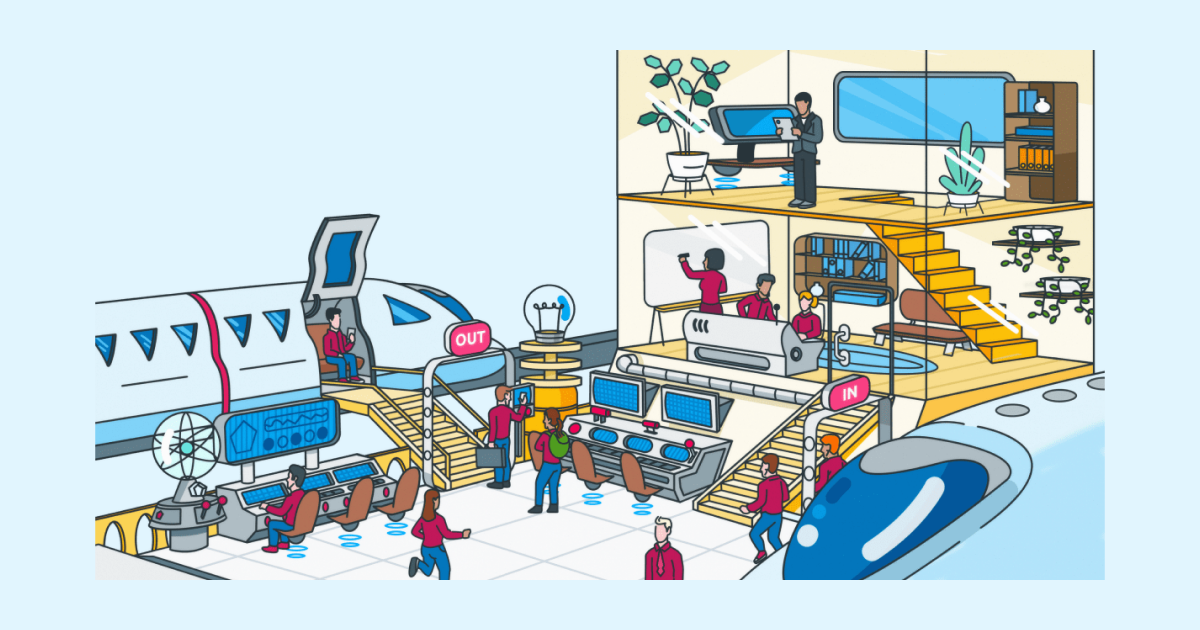Practices that benefit teal organizations: Interview with MTA Digital
Last updated on: May 30, 2022
“The future of management is teal” can be heard more and more often. According to some articles, teal organizations focus less on the bottom line and shareholder value, but they have better financial results than their competitors.
What are teal organizations?
How do they function?
Why is time tracking so important to them?
How do they manage their time, projects, and team(s)?
To find out the answers, we talked with Justyna Wasielewska, Clockify Role Supervisor, and Mateusz Mikołajczyk, PM Global, from performance marketing agency MTA Digital that follows the Teal approach.

Table of Contents
What are teal organizations?
The term teal organization came from the book Reinventing Organizations by Frederic Laloux. According to the Laloux Culture Model, cited in the book, organizations can be red, amber, orange, green, or teal.
Teal organizations have distributed authority, often functioning as decentralized, self-managed teams — the metaphor for teal organizations is a living organism. Hierarchies are fluid and natural — decision-making power goes to whoever has the most knowledge, interest, and passion on the topic. Trust is a big thing, as well: there’s no micromanaging, every team member is trusted to do their job the best they can. It can be a great organizational model for both profit and non-profit organizations.
Teal organizations enable three breakthroughs:
- Self-management: They operate effectively using a system based on peer relationships. Power and control are not tied to specific positions.
- Wholeness: They reject “traditional” professionalism that prefers masculinity and extroversion; instead, they let that their workers bring their “whole self” to work (a.k.a. be fully themselves) and create a safe work environment.
- Evolutionary purpose: Teal organizations have a strong sense of purpose and base their strategies on what they sense the world needs from them. In accordance with the “living organism” metaphor, their purpose is not static, but always evolving: instead of trying to predict and control the future like traditional companies do, teal organizations listen in and constantly reshape and refine their purpose.
To better understand teal organizations, let’s also see what the other colors from the Laloux Culture Model symbolize for organizations.
Contrasting teal organizations with red organizations
Red organizations have a strong leader who has absolute power over the others. Subordinates follow the orders of the boss with no questions asked (“or else…”). They represent the most basic form of human organization.
Contrasting teal organizations with amber organizations
Amber organizations have a strict hierarchy, reporting lines, formal roles, and a chain of command. The dominant leadership style is “command and control” — those on upper levels give orders and those on lower levels follow them. These organizations thrive in stable and predictable environments.
Examples of an amber organization are the military, public schools, and government agencies.
Contrasting teal organizations with orange organizations
Orange organizations are focused on innovation: What do we need to do to improve? How do we come up with something bigger and better? How do we beat the competition?
The pyramidal structure is still present, but decision-making authority is now shared with more people. Since these organizations are results-oriented, there’s a meritocracy based on who delivers the best results.
Examples of orange organizations are big corporations and public universities.
Contrasting teal organizations with green organizations
Green organizations strive to resemble families. They want to empower and motivate employees. Other than profit, they have a strong company culture, defined values, and a role in the community. Their structure is less hierarchical and resembles an inverted pyramid: CEOs and leaders serve, rather than direct their organizations.
The most commonly used examples are culture-driven organizations, such as Southwest Airlines and Ben and Jerry’s.
How do teal organizations function?
It’s a common misconception that there is no hierarchy or bosses in teal organizations. There are, but their approach is different than in more traditional organizations. Here’s what Justyna Wasielewska and Mateusz Mikołajczyk have to say on the subject:
“The fact that a person is our Team Leader doesn’t mean that their opinion is always superior and that only they are allowed to make any decision in the team. We see Team Leaders more like people who have a holistic view of the team, and those who see the “big picture” of projects. Their job is to help individual team members solve problems, facilitate the flow of work, and generally “connect the dots.”
An example of how teal organizations function
Our interviewees further illustrated the way these types of organizations work:
“Imagine that, with a pack of your friends, you’re planning the trip to the mountains in ex. China (foreign, and quite exotic country for eastern culture) — you want to climb, eat local food, visit some places. Some of those friends are the experienced climber, the cook, and someone who speaks Chinese. Who should be “the boss” of the whole trip?
It’s natural, that, in terms of climbing and safety — you’d listen to the climber, the cook will be your guide to local cuisine, and you’ll leave the communication with locals to the one who speaks Chinese. So each of them is a kind of “the boss” in their area of specialization.
The same applies at MTA — so the hierarchy is not given by CEOs, leaders, etc., but it’s more based on meritocracy, where everyone can be “the boss” of some part of the organization, which he/she is specialized in. For example — being specialized in Facebook Ads, I don’t have the knowledge to decide how should we take care of our client’s Google Ads accounts. Everyone just has a different role to play in the organization, so we could grow and evolve, and no one is superior.”
Why is time tracking important for teal organizations?
For a teal organization to function well, everyone needs great organizational and decision-making skills. That is often achieved by tracking time. This practice has many benefits, from easier task prioritization to better time management.
Time tracking significantly facilitates:
- Keeping track of what everyone is doing
- Finding out how long it takes each member to complete their tasks
- Maintaining motivation and a high productivity level
- Reducing procrastination and idle time
- Calculating the project’s profitability
- Keeping everyone accountable
- Seeing where exactly the project budget is going
When you track your time, you can analyze the time you spend on individual tasks and projects as a whole, as well as create analytics of all activities as an organization.
MTA Digital team shared the biggest time tracking benefits for them:
“If you combine the data with projects and their incomes, it’s a super-powerful combo that allows you to dig really deep into data. As a result, we can better understand our business, manage teams, and find out which projects generate the most income.
For example, by estimating the monthly time of each specialist and the time of the projects, we’re able to see, if and how many new specialists we may need to hire in the upcoming months.”
💡 Check out How to start tracking your time and How to explain the need for time tracking to your team.
Which time tracker works best for teal organizations?
MTA’s choice is Clockify:
“In our opinion, Clockify does indeed have many advantages that we haven’t found in other similar tools. Some of those that made it number one for us are:
- price,
- responsiveness of Clockify support,
- adjustability,
- Chrome plugin,
- integration with Asana, Google Calendar, and Gmail,
- “Do not allow saving time without…” option.”
According to Wasielewska and Mikołajczyk, the Clockify feature that helps their organization the most is “using the API and linking it to Google Sheets via Google Scripts. With this feature (as we wrote in our own case study) we manage the basic elements of the organization’s functioning, such as the profitability of projects, the creation of reports for clients, or the payroll.”
Tips for applying the teal approach to your organization
As good as working in teal organizations sounds, it’s not for everyone. If you don’t have good time management skills and don’t like taking responsibility and making decisions (instead of just following instructions), this approach may not work for you.
However, if all the advantages — strong relationships between team members, almost unlimited possibilities to shape your own development path, and freedom to make decisions, just to name a few — sound too good to not give it a try, there are a couple of things you should keep in mind.
These tips helped Wasielewska, Mikołajczyk, and their team the most:
Hire people you can trust
Trust is one of the main values of teal organizations. It begins from the first step of the process — hiring.
“Hire people you can trust, and REALLY trust them, and LET THEM DO THEIR JOB, make their decisions, make mistakes and learn, while fully supporting them. Build the infrastructure of the organization, so they could use their best skills, and help them understand the common goal, so you could achieve it together. This type of system kind of enforces a two-way trust. If you are not able — as a company manager — to trust your employees to make rational decisions for the good of the business, then teal is absolutely not the solution for you.”
Help co-workers in a respectful way
Treat your coworkers as your equals and avoid micromanaging at all costs.
“Try to help the ones you are coworking with — don’t treat them like children who don’t know what to do and need your guidance in every area. Listen to them, and always try to find win-win solutions, rather than focusing on mistakes and problems themselves.”
Encourage transparency
Trust (that we previously talked about) and transparency go hand in hand. Both are a two-way street — start with yourself, so you can expect it from others.
“Be transparent — fully transparent, show everyone your perspective, and don’t hide what you think. I am a great supporter of the principle of radical honesty (read Kim’s Scott Radical Candor for more info ?).”
Link salaries with performance
Make a good salary a natural consequence of excellent performance and effort.
“It’s also helpful, and for us super important, to link salaries with performance. With that implemented, organization members learn that the money doesn’t come from “the boss” and the relationship you have with her/him, but that your salary is a bonus for a well-done job, and that money comes from satisfied clients.”
Conclusion
With its unique approach to business, fluid hierarchies, and self-regulation of the system, teal definitely seems like the future of management. However, it requires a specific skill set to make sure everything goes smoothly — team members need excellent organizational and time management skills.
Time tracking is one of the most important things to do to stay on top of all the work in teal organizations. It helps with keeping track of what everyone is doing, calculating the project’s profitability, and keeping everyone accountable.
✉️ What’s your opinion of teal organizations? Does the teal approach sound like something you would like to implement in your organization? If you work in a teal organization, how did time tracking benefit your organization? Let us know at blogfeedback@clockify.me for a chance to be featured in this or future posts.




